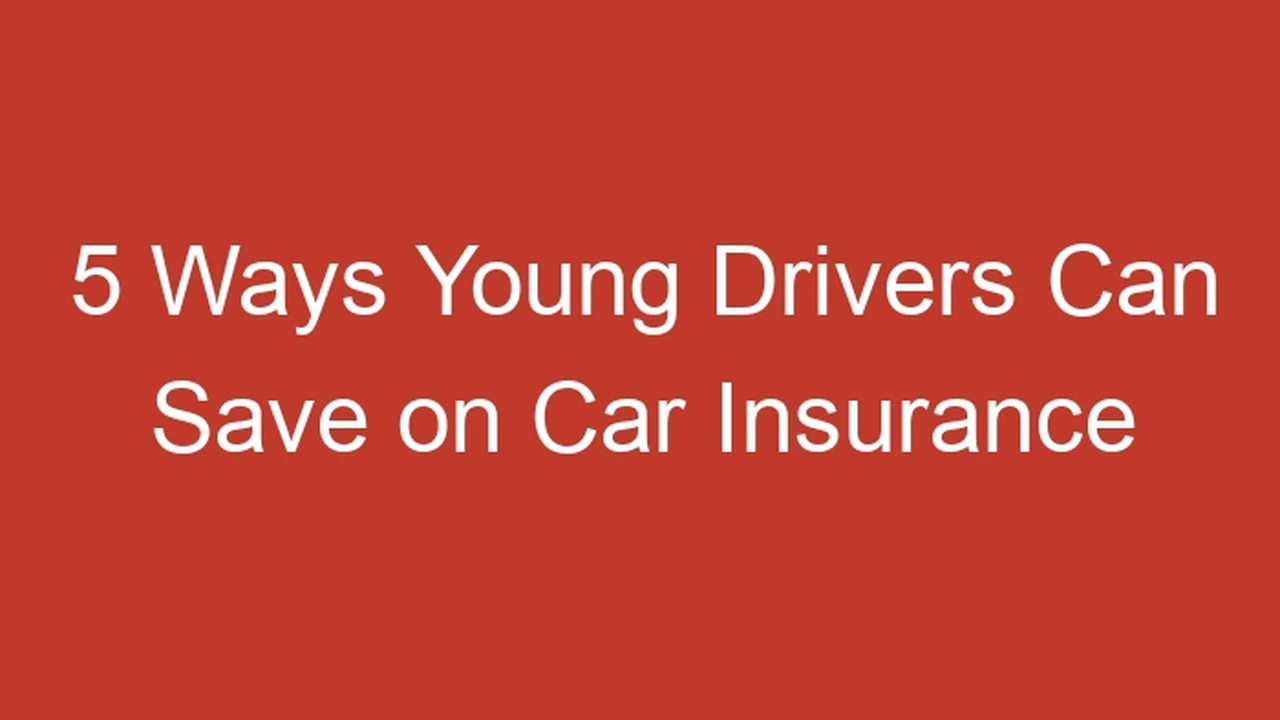5 Steps to Take After an Auto Accident for Insurance Claims
Discover 5 advanced strategies to maximize auto insurance savings. Go beyond basic discounts to significantly reduce your premiums.

Discover 5 advanced strategies to maximize auto insurance savings. Go beyond basic discounts to significantly reduce your premiums. Let's dive deep into how you can slash your auto insurance costs without compromising on essential coverage. We're talking about smart moves that many drivers overlook, but which can lead to substantial savings in the long run. This isn't just about finding a cheaper policy; it's about optimizing your entire approach to car insurance.
5 Advanced Strategies to Maximize Auto Insurance Savings Beyond Basic Discounts
Alright, let's get real about auto insurance. Everyone wants to save money, right? But often, we just scratch the surface, looking for the most obvious discounts. What if I told you there are deeper, more strategic ways to cut down your premiums? This isn't about sacrificing coverage; it's about being smarter with your choices. We're going to explore five advanced strategies that go way beyond the usual 'good driver' or 'multi-car' discounts. These are tactics that can truly make a difference to your wallet, especially if you're in the USA or Southeast Asia, where insurance markets can be quite competitive.
Strategy 1 Optimize Your Vehicle Choice for Insurance Savings
This might sound obvious, but many people don't consider insurance costs when buying a car. It's not just about the purchase price; it's about how much it costs to insure. Certain vehicles are inherently more expensive to insure due to various factors like repair costs, theft rates, and safety ratings. Thinking about this upfront can save you thousands over the lifetime of your vehicle.
Understanding Vehicle Insurance Risk Factors
Insurance companies assess risk based on several vehicle characteristics:
- Repair Costs: Cars with expensive parts or complex repair processes (think luxury brands, high-performance vehicles, or those with advanced tech like intricate sensor systems) will cost more to insure.
- Theft Rates: Vehicles frequently targeted by thieves will have higher comprehensive coverage premiums.
- Safety Ratings: Cars with excellent safety ratings (e.g., from IIHS or NHTSA in the US, or ASEAN NCAP in Southeast Asia) often qualify for safety discounts and are generally cheaper to insure because they reduce the likelihood of severe injuries and associated claims.
- Engine Size and Horsepower: More powerful cars are often associated with higher speeds and thus a greater risk of accidents, leading to higher premiums.
- Vehicle Age: Newer cars typically cost more to insure due to their higher replacement value, but older cars might have higher liability if they lack modern safety features.
Recommended Vehicles for Lower Insurance Premiums
If you're in the market for a new or used car and want to keep insurance costs down, consider models known for their affordability to insure. Generally, these are sedans, minivans, and some SUVs that have good safety records, are not high-performance, and have readily available, affordable parts.
USA Market Examples:
- Honda CR-V: Known for reliability, good safety ratings, and moderate repair costs.
- Subaru Outback: Excellent safety features, good for families, and generally reasonable to insure.
- Toyota RAV4: Another reliable SUV with good safety scores and low theft rates.
- Ford Escape: A popular compact SUV that often comes with competitive insurance rates.
- Nissan Rogue: Offers good value and typically doesn't break the bank on insurance.
Southeast Asia Market Examples:
- Toyota Vios (Yaris Sedan): Extremely popular in countries like Thailand, Malaysia, and the Philippines. Known for reliability and affordable parts.
- Honda City: Another strong contender in the compact sedan segment, with good safety and widespread service networks.
- Perodua Myvi (Malaysia): A top-selling local car with very affordable insurance due to low repair costs and high parts availability.
- Mitsubishi Xpander (Indonesia, Philippines): A popular MPV with good practicality and generally reasonable insurance.
- Suzuki Swift: A compact hatchback that's fuel-efficient and often has lower insurance premiums.
Comparing Specific Models and Their Insurance Impact
Let's do a quick hypothetical comparison. Imagine you're choosing between a sports car like a Ford Mustang GT and a family sedan like a Honda Accord. Even if their purchase prices are similar, the Mustang will almost certainly have significantly higher insurance premiums due to its higher performance, higher theft risk, and potentially higher repair costs for specialized parts. Always get insurance quotes for specific models before making a final purchase decision. Websites like NerdWallet or Compare the Market (though UK-based, the principles apply) can give you a good starting point for research.
Strategy 2 Leverage Telematics and Usage Based Insurance UBI Programs
Telematics, often referred to as Usage-Based Insurance (UBI), is a game-changer for safe drivers. These programs use devices or smartphone apps to monitor your driving habits, such as speed, braking, acceleration, and mileage. If you demonstrate safe driving, you can earn significant discounts on your premiums. It's like getting a personalized discount based on how you actually drive, not just general statistics.
How Telematics Programs Work and Their Benefits
Typically, you enroll in a program, and the insurer provides a small device to plug into your car's OBD-II port, or you download their app. This device/app collects data on your driving behavior over a period (usually 3-6 months). Based on this data, the insurer calculates a personalized discount. The benefits are clear:
- Personalized Discounts: Safe drivers can see discounts of 10-30% or even more.
- Improved Driving Habits: Knowing you're being monitored can encourage safer driving.
- Fairer Premiums: Your rates are based on your actual risk, not just demographic averages.
Leading Telematics Products and Providers
Many major insurers offer UBI programs. Here are some prominent ones:
USA Market:
- Progressive Snapshot: One of the pioneers. You can use a plug-in device or their mobile app. They offer an initial discount just for signing up, and then a personalized rate at renewal.
- State Farm Drive Safe & Save: Uses the Car Connection device or the State Farm mobile app. Discounts can be up to 30%.
- Allstate Drivewise: Available via their mobile app. Offers cash rewards for safe driving and discounts on premiums.
- GEICO DriveEasy: Mobile app-based program that monitors driving and offers discounts.
- Liberty Mutual RightTrack: Uses a plug-in device or mobile app. Offers an initial discount and then a final discount based on driving behavior.
Southeast Asia Market:
Telematics is growing in Southeast Asia, often integrated with newer car models or offered by innovative insurers.
- AXA SmartDrive (Singapore, Malaysia): Offers telematics-based insurance with discounts for safe driving. Often comes with additional features like accident alerts.
- FWD Insurance (Thailand, Singapore): Has programs that reward safe driving through app-based monitoring.
- MSIG (Various SEA countries): Some MSIG policies offer telematics options, especially for fleet insurance, but increasingly for individual drivers.
- Local Insurers with OEM Partnerships: Many local insurers partner with car manufacturers (e.g., Toyota, Honda) to offer integrated telematics services, especially for newer vehicles with built-in connectivity. Check with your car dealer or local insurer for specific programs.
Typical Savings and Usage Scenarios
Savings can vary widely, but it's not uncommon to see initial discounts of 5-10% just for enrolling, with potential renewal discounts reaching 15-30% for consistently safe drivers. These programs are particularly beneficial for:
- Low-mileage drivers: If you don't drive much, your risk is lower, and telematics can reflect that.
- Safe drivers: If you have a clean driving record and practice good habits, you'll be rewarded.
- Young drivers: This can be a way for young drivers to prove their responsibility and offset high initial premiums.
Important Note: While most UBI programs only offer discounts for good driving, some might increase your premium if your driving is deemed risky. Always read the terms and conditions carefully.
Strategy 3 Master the Art of Policy Bundling and Multi Policy Discounts
Everyone knows about bundling home and auto insurance, but this strategy goes deeper. Many insurers offer discounts for combining various types of policies, not just the obvious ones. This can lead to significant savings and simplify your insurance management.
Beyond Home and Auto Exploring Other Bundling Options
Think about all the insurance you might need:
- Renters Insurance: If you rent, bundling renters insurance with your auto policy can often yield a discount on both.
- Life Insurance: Many major insurers (like State Farm, Allstate, Prudential) offer life insurance. Bundling it with auto can provide a discount.
- Motorcycle/RV/Boat Insurance: If you have other vehicles, insuring them with the same company as your car can lead to multi-vehicle discounts.
- Umbrella Policy: An umbrella policy provides extra liability coverage beyond your home and auto limits. Bundling it often comes with a discount.
- Pet Insurance: Some insurers are starting to offer discounts for bundling pet insurance.
Comparing Multi Policy Discount Structures Across Insurers
The percentage of discount for bundling varies by insurer and the types of policies combined. It's crucial to get quotes from multiple providers to see who offers the best overall package.
USA Market Examples:
- GEICO: Known for competitive rates and multi-policy discounts, often advertising savings for bundling auto with home, renters, or even motorcycle insurance.
- Progressive: Offers a 'multi-policy discount' for combining two or more policies, including auto, home, renters, boat, RV, and more.
- Allstate: Their 'Multi-Policy Discount' can apply to auto, home, renters, condo, and life insurance.
- Farmers Insurance: Offers significant discounts for bundling auto with home, renters, or life insurance.
- Liberty Mutual: Provides discounts for combining auto with home, renters, or even landlord insurance.
Southeast Asia Market Examples:
Bundling is also a growing trend here, though perhaps not as extensive as in the US.
- AXA (Singapore, Malaysia, Thailand): Often offers discounts for bundling motor insurance with home insurance or personal accident plans.
- FWD Insurance (Thailand, Singapore): Known for flexible policies and often provides incentives for customers who hold multiple policies with them.
- MSIG (Various SEA countries): Offers multi-policy discounts, especially for combining motor with home or travel insurance.
- Great Eastern (Singapore, Malaysia): A major insurer that provides discounts for bundling various general insurance products with life insurance.
Practical Steps to Maximize Your Bundling Savings
- Inventory Your Policies: List all the insurance policies you currently hold (auto, home, renters, life, health, pet, etc.) and their renewal dates.
- Get Comprehensive Quotes: When shopping for auto insurance, always ask for a quote that includes all other policies you might consider bundling. Don't just get an auto-only quote.
- Consider a Single Provider: While not always the cheapest, having all your policies with one provider can simplify management and often lead to the largest discounts.
- Review Annually: Your insurance needs change. Review your policies and bundling options annually to ensure you're still getting the best deal.
Strategy 4 Optimize Your Deductibles and Coverage Limits for Cost Efficiency
This is where many people either overpay or under-insure. Finding the sweet spot for your deductibles and coverage limits is crucial for maximizing savings without leaving yourself exposed to financial risk. It's a balancing act that depends on your financial situation and risk tolerance.
Understanding Deductibles and Their Impact on Premiums
Your deductible is the amount you pay out-of-pocket before your insurance kicks in for a covered claim. Generally, a higher deductible means a lower premium, and vice-versa. Why? Because you're taking on more of the initial risk.
- Low Deductible (e.g., $250-$500): Higher premiums, less out-of-pocket in case of a claim. Good if you have limited savings or prefer predictable costs.
- High Deductible (e.g., $1,000-$2,500+): Lower premiums, more out-of-pocket in case of a claim. Ideal if you have a healthy emergency fund and are comfortable taking on more risk.
Recommendation: If you have a solid emergency fund (enough to cover a $1,000 or $2,500 deductible without stress), opting for a higher deductible can significantly reduce your annual premiums. Just make sure that emergency fund is easily accessible.
Adjusting Coverage Limits for Liability and Comprehensive Collision
Coverage limits define the maximum amount your insurer will pay for a covered loss. This applies to liability (bodily injury and property damage), comprehensive, and collision coverage.
Liability Coverage:
This covers damages you cause to others. State minimums are often very low and might not be enough to protect your assets in a serious accident. While increasing liability limits will raise your premium, it's often a wise investment, especially if you have significant assets to protect. Consider limits like 100/300/50 (meaning $100,000 per person for bodily injury, $300,000 per accident for bodily injury, and $50,000 for property damage) or even higher.
Comprehensive and Collision Coverage:
These cover damage to your own vehicle. As your car ages and depreciates, the value of these coverages decreases. At some point, the cost of comprehensive and collision might outweigh the potential payout, especially if your car is old and has a low market value. For example, if your car is only worth $3,000, and your annual comprehensive/collision premium is $800 with a $1,000 deductible, you're paying a lot for very little potential benefit. Consider dropping these coverages on older, low-value vehicles to save money.
When to Drop Certain Coverages
- Collision and Comprehensive: Consider dropping these when your car's market value is less than 10 times your annual premium for these coverages, or if you can comfortably afford to replace the car out-of-pocket.
- Rental Car Reimbursement: If you have a second car or can easily manage without a rental for a few days, this might be an optional coverage to drop.
- Roadside Assistance: If you're already a member of AAA or a similar service, or if your car manufacturer offers roadside assistance, you might not need this through your insurer.
Scenario Based Coverage Adjustments
- New Car Owner: Keep higher comprehensive and collision limits, and consider GAP insurance.
- Older Car Owner: Evaluate dropping comprehensive and collision. Maintain strong liability.
- High Net Worth Individual: Maximize liability coverage and consider an umbrella policy to protect assets.
- Limited Driving: If you drive very little, consider a UBI program and potentially higher deductibles.
Strategy 5 Proactively Manage Your Credit Score and Driving Record for Better Rates
While not directly an insurance strategy, your credit score and driving record are two of the most significant factors influencing your auto insurance premiums. Proactively managing them can lead to substantial long-term savings.
The Impact of Credit Score on Auto Insurance Premiums
In many US states (and increasingly in some Southeast Asian markets), insurers use a credit-based insurance score to help determine your rates. This score is derived from your credit report and is a strong predictor of future claims. Drivers with excellent credit scores often pay significantly less for auto insurance than those with poor credit scores.
How to Improve Your Credit Score:
- Pay Bills on Time: Payment history is the most crucial factor.
- Reduce Debt: Lower your credit utilization ratio (the amount of credit you use compared to your total available credit).
- Avoid Opening Too Many New Accounts: Each new credit inquiry can temporarily ding your score.
- Check Your Credit Report Regularly: Dispute any errors that could be negatively impacting your score. Websites like AnnualCreditReport.com (USA) allow you to get free reports.
Maintaining a Clean Driving Record and Its Benefits
This is perhaps the most straightforward way to save money on auto insurance. A clean driving record (no accidents, no tickets) signals to insurers that you are a low-risk driver.
Benefits of a Clean Driving Record:
- Good Driver Discounts: Most insurers offer significant discounts for drivers with no accidents or violations for a certain period (e.g., 3-5 years).
- Accident Forgiveness: Some policies offer accident forgiveness, meaning your rates won't increase after your first at-fault accident, but you usually need a clean record to qualify.
- Lower Premiums Overall: Without incidents, your base premium will be much lower.
Tips for Maintaining a Clean Driving Record:
- Drive Defensively: Always be aware of your surroundings and anticipate potential hazards.
- Obey Traffic Laws: Speed limits, stop signs, and traffic signals are there for a reason.
- Avoid Distracted Driving: Put away your phone and focus on the road.
- Consider a Defensive Driving Course: Some insurers offer discounts for completing an approved defensive driving course, and it can refresh your skills.
The Long Term Financial Impact of Proactive Management
The effects of a good credit score and a clean driving record compound over time. Not only will you pay less for auto insurance, but a good credit score also helps with loans, mortgages, and even some job applications. A clean driving record means fewer headaches, lower stress, and ultimately, more money in your pocket. It's an investment in your financial future that pays dividends year after year.
By implementing these advanced strategies, you're not just looking for quick fixes; you're building a robust approach to managing your auto insurance costs. It requires a bit more thought and proactive effort, but the savings can be substantial and long-lasting. So, take control, be informed, and drive smart – your wallet will thank you!
:max_bytes(150000):strip_icc()/277019-baked-pork-chops-with-cream-of-mushroom-soup-DDMFS-beauty-4x3-BG-7505-5762b731cf30447d9cbbbbbf387beafa.jpg)






